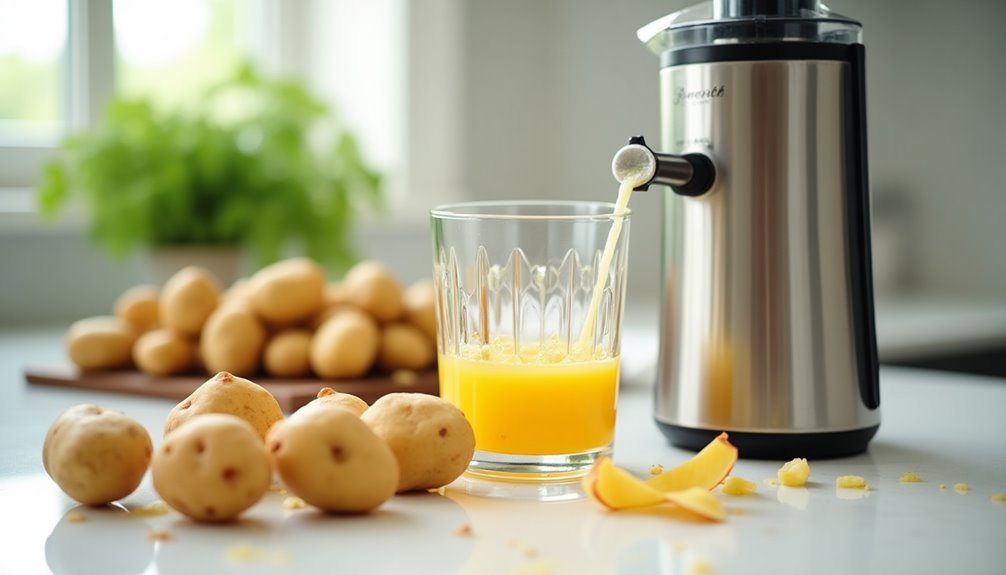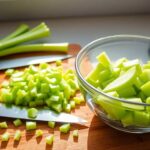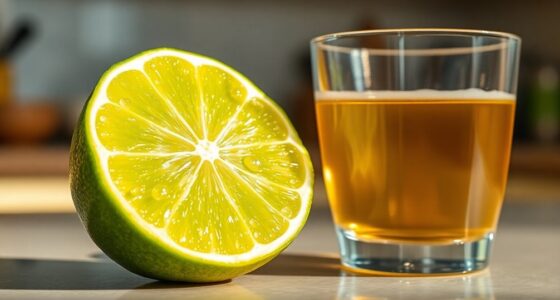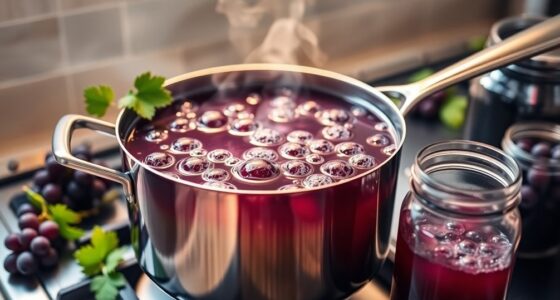To make potato juice, start with raw, unpeeled potatoes. Wash them well, then cut them into small cubes. Use a juicer or a blender—if you're blending, add a splash of water for a smoother consistency. Blend until smooth, then strain the mixture through a mesh strainer to separate the juice from the pulp. For the best health benefits, drink it fresh, ideally 30 minutes before meals. There's more to discover about enhancing flavor and storage options!
Key Takeaways
- Choose raw, well-washed potatoes, avoiding any with dark spots or green areas.
- Cut potatoes into small cubes for easier juicing.
- Use a juicer or blender, adding a little water if blending, and blend until smooth.
- Strain the mixture through a mesh strainer to separate juice from pulp.
- Drink fresh potato juice 30 minutes before meals for maximum health benefits.

Making potato juice is a simple and rewarding process that can boost your health. If you're curious about juicing a potato, you'll find it's not only easy but also packed with benefits. To get started, you'll want to select raw, unpeeled potatoes. Make sure they're well-washed, and avoid any that have dark spots or green areas, as these can affect the quality of your juice. Cut the potatoes into small cubes; this will make the juicing process smoother and more efficient.
Once you've prepared your potatoes, it's time to get juicing. You can use either a juicer or a blender for this task. If you're opting for a blender, add a little water to help facilitate smoother blending. Using just enough liquid will ensure that you get a consistent texture without diluting the health benefits of the potato juice. Blend the potato cubes until you have a smooth mixture.
After blending, you'll need to strain the mixture through a mesh strainer to extract the juice. This step is essential, as it separates the pulp from the juice, leaving you with a refreshing drink.
When it comes to consuming potato juice, timing is crucial. For the best health benefits, drink it fresh and ideally 30 minutes before your meals. This timing can improve your gastrointestinal health and can offer relief from symptoms associated with gastritis. You'll want to keep your potato juice close by, so you can enjoy it right away before your meals.
If you're looking to enhance the flavor and nutritional value of your potato juice, consider mixing it with other fruits or vegetables. Carrots and apples make excellent companions for potato juice, adding a touch of sweetness and additional vitamins. The combination can create a delicious and health-boosting drink that you'll want to make regularly.
Storing any leftover potato juice is an option, but keep in mind that it's best enjoyed fresh. If you do have some remaining, place it in an airtight container and store it in the refrigerator. It can last for up to a few months, but for maximum nutrient retention, consuming it immediately is the way to go.
Frequently Asked Questions
How to Make Potato Juice at Home?
To make potato juice at home, start with fresh, unpeeled potatoes.
Wash them thoroughly, cut them into small cubes, and use a juicer or blender for extraction.
If you're blending, add a bit of water to help the process.
After blending, strain the mixture to separate the juice from the pulp.
Enjoy the juice on its own or mix it into smoothies for added benefits.
Store any leftovers in the fridge for later use.
How Do You Extract Juice From Potatoes?
Imagine a crisp morning, where you seek nourishment from nature's bounty.
To extract juice from potatoes, start by cubing fresh, clean potatoes. You can feed these into a juicer or blend them with a bit of water until smooth.
Strain the mixture through a mesh strainer to separate the juice from the pulp. Remember to mix the silky paste that settles at the bottom back into the juice for maximum nutrients. Once you have your fresh juice, you can explore ways to extend its shelf life. If you’re curious about how to prepare frozen orange juice, simply pour the fresh juice into ice cube trays or freezer-safe containers and freeze. This method allows you to enjoy the refreshing taste and nutritional benefits of orange juice at a later date.
Enjoy the freshness!
How to Make Potato Liquid?
To make potato liquid, you'll need fresh potatoes. Start by washing and peeling them, then cut them into small cubes.
You can either use a juicer or a blender. If using a blender, add a little water to help achieve a smoother consistency. Blend until smooth, then strain the mixture through a fine mesh strainer to separate the liquid from the pulp.
Enjoy your potato liquid fresh for the best taste and nutrients!
How Many Days Does Potato Juice Take to Remove Dark Spots?
Isn't it frustrating when dark spots linger on your skin? If you apply potato juice regularly, you might see improvements in just 2 to 4 weeks.
Each day counts, so consistency is crucial. You'll want to target the dark spots directly, leaving the juice on for about 20 minutes before rinsing.
Conclusion
Making potato juice isn't just about the drink; it's a journey of transformation. Just as potatoes grow from humble soil to nourish our bodies, your effort in this process symbolizes growth and renewal. Each drop of juice reflects the potential within you—simple yet powerful. So, as you sip your homemade creation, remember that even the most ordinary ingredients can lead to extraordinary results. Embrace this lesson, and let it inspire you to nurture your own potential.
Cindy thoroughly researches juicing trends, techniques, and recipes to provide readers with practical advice and inspiration. Her writing style is accessible, engaging, and designed to make complex concepts easy to understand. Cindy’s dedication to promoting the advantages of juicing shines through her work, empowering readers to make positive changes in their lives through the simple act of juicing.
















